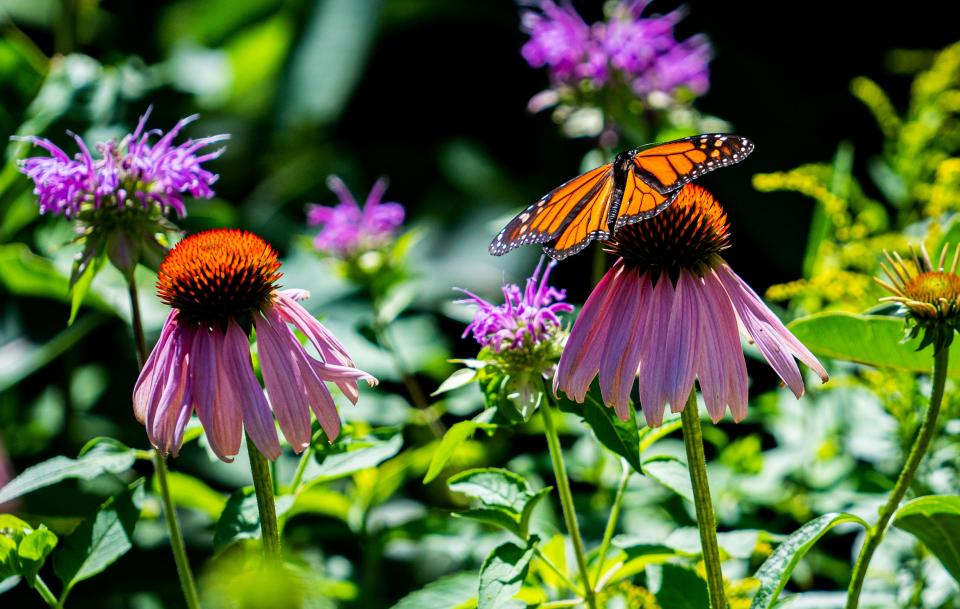Wauwatosa and Brookfield residents are working to gain community wildlife certifications
A small sign poking out of the ground on Cornelia Beilke’s front yard in Wauwatosa signals that her garden isn’t just a pretty sight, but a welcome haven for local wildlife.
The sign reads "Certified Wildlife Habitat" and is from the National Wildlife Federation. Similar signs sit in hundreds of thousands of properties nationwide that, like Beilke's, are recognized by the conservation organization for providing pollinators and other wildlife pesticide-free environments with food, water, cover for shelter and places to raise young.
Beilke, a music teacher, certified her own property in 2011. It wasn’t until last year when she met Nicci Sternitzky, a Village of Elm Grove resident, that she learned entire towns and cities can be recognized as wildlife habitats by the National Wildlife Federation.
Sternitzky helped Elm Grove become the first place in Wisconsin and 150th in the country to earn the "Community Wildlife Habitat" certificate last year by going door to door and certifying more than 120 homes, businesses and schools as wildlife-friendly spaces.
Once Elm Grove earned the certificate, Sternitzky and other volunteers on the village's Beautification Committee started a "tag, you're it" initiative to nudge people in neighboring municipalities like Beilke's to certify their own communities.
Now, residents in Wauwatosa and Brookfield are organizing to get enough neighbors and local groups commit to planting native species and earn their municipalities the community-wide certification of being a welcoming habitat birds, insects and other wildlife.
How can a yard or garden become a Certified Wildlife Habitat?
The National Wildlife Federation provides a checklist of elements that are required for a property to be certified. Beilke thinks many Wauwatosa properties won't have to make major changes to qualify ― she's seen neighbors leaving the trend of monotonous grassy yards behind and planting more wildflowers.
“What encouraged me is how many people already have all those elements, and all they have to do is get certified,” Beilke said.
Here’s a list of the elements a property must have to become Certified Wildlife Habitat:
A minimum of three types of food, including native plants, berries or seeds, pollen, a bird feeder, foliage or twigs.
One source of water for wildlife to drink and bathe in, which could be a birdbath, rain garden, a seasonal pool or natural water sources like rivers and lakes that are near but not on a property.
At least two places to find shelter, like a rock pile, dense shrubs, brush, or a log pile.
At least two places to raise young, which could include host plants for caterpillars, mature trees, fallen leaf debris, or dense shrubs.
Use at least two sustainable practices, like the elimination of chemical pesticides or fertilizers, composting, soil and water conservation tactics, reducing lawn areas and using native plants.
Once a resident walks through the checklist, they can certify their property on the Certified Wildlife Habitat website. There is a $20 application processing fee and cost to purchase a sign, and both costs go to the National Wildlife Federation’s programs.

How can places like Brookfield and Wauwatosa become 'Certified Wildlife Habitat' communities?
It takes a lot of talking to neighbors to turn a community into a National Wildlife Federation-certified Community Wildlife Habitat.
A resident first must register their municipality for the program and pay the National Wildlife Federation a $90 fee. Then, the registered community is assigned a number of points it'll need to reach based on its population.
Groups gain their municipality points for certifying properties as wildlife habitats, holding educational events and providing resources like native plant lists.
Elm Grove received its 150 points by certifying over 120 homes, businesses and schools as wildlife-friendly spaces, according to Sternitzky. A volunteer team educated residents by offering free site visits to Elm Grove businesses and homes.
"Our team would go to someone's house with a checklist from the National Wildlife Federation, and go over what does this mean? What do I need to do? What can I do differently?" Sternitzky said.
From there, they would write up recommendations of steps the resident could take to certify their property.
"It really taught me that a lot of people aren't not doing things because they don't care, it's just because they don't potentially know."
Wauwatosa needs to earn 250 points to gain certification
Beilke said Wauwatosa needs to earn 250 points and her team's game plan has been to spread the word at local events, in a local newsletter and by simply telling neighbors about the effort.
“I'm at this point where anybody I talk to it's like, ‘Oh, is your garden certified?’” Beilke said with a laugh.
Some parks and public spaces in Wauwatosa already qualify as certified wildlife habitats, and it will just be a matter of educating people about the certification program, said Frankie Garr, a Wauwatosa resident involved in the community's efforts.
She plans to write a proclamation for the mayor and city officials to sign off on.
Brookfield residents focus wildlife habitat certification initiative on native plant education
Residents in the City of Brookfield have also gotten their city involved in the effort. Deanna Wargowski said she and others involved in Brookfield's effort will work with the Department of Public Works to certify the city's parks.
She and Nancy Gloe are working with other volunteers to help educate neighbors about removing invasive species in their backyards and including native plants.
"We're working to change the mindset of people," Nancy Gloe said.
In Brookfield, about 40 homeowners have certified their yards. Anyone who would like to join the Brookfield effort can contact the team at BrookfieldNWFTeam@gmail.com.
Bridget Fogarty can be reached at bfogarty@gannett.com
This article originally appeared on Milwaukee Journal Sentinel: Wauwatosa and Brookfield look to gain wildlife habitat certifications

